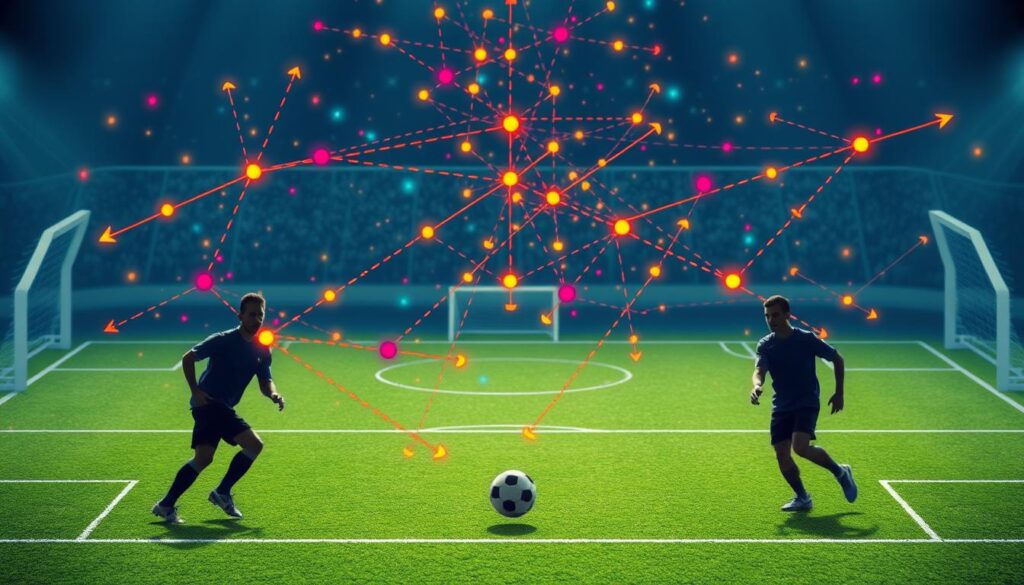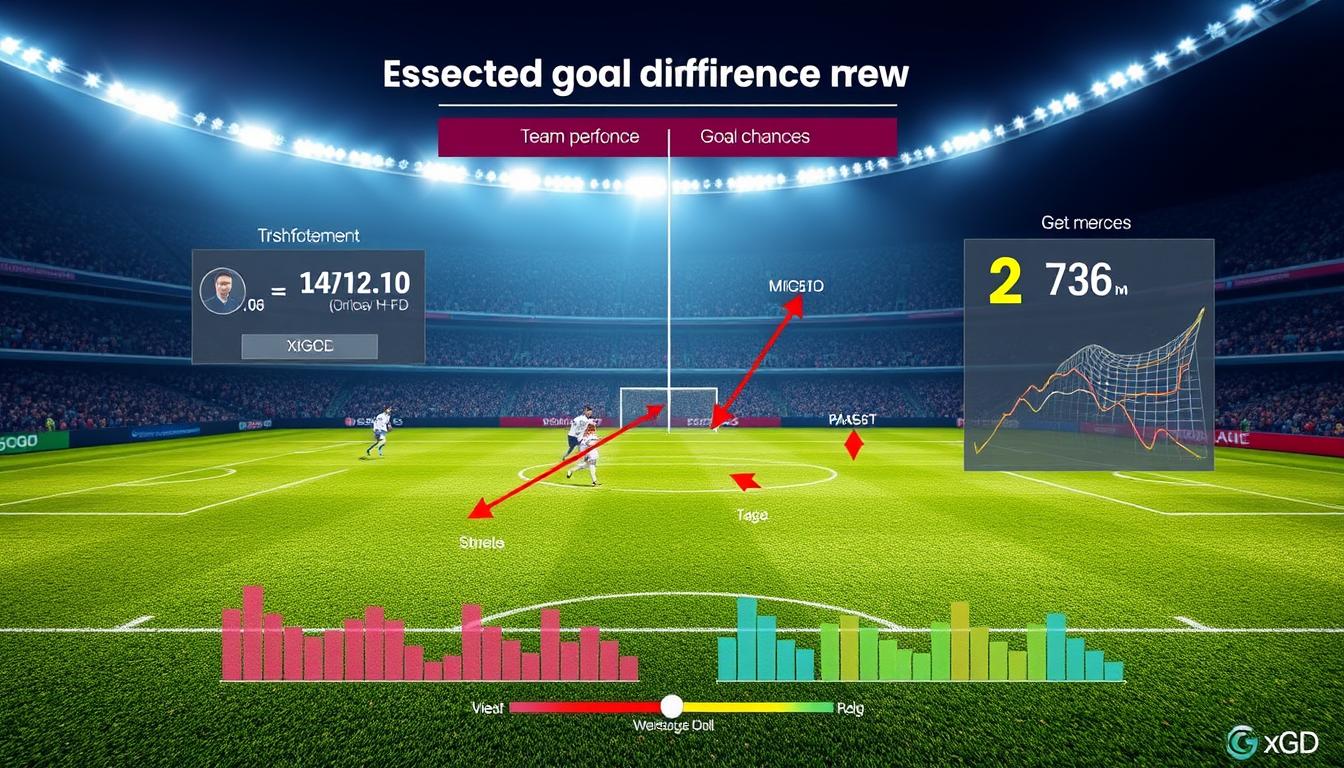In the high-stakes world of professional soccer, every tactical decision can make the difference between victory and defeat. Surprisingly, a mathematical concept developed over a century ago by Russian mathematician Andrey Markov is now at the forefront of strategic sports analysis. Markov Chains, a tool once isolated to abstract mathematics, are now instrumental in delivering Tactical Insights into the dynamic world of soccer, transforming heaps of raw event stream data into analytical gold, guiding in-game decisions with precision and foresight12.
Top-tier teams like Manchester City FC, Liverpool FC, and FC Barcelona are leveraging these models, which dissect the game into a series of Game State Transitions. These transitions sketch out a map on which a soccer match unfolds, covering every pass, tackle, and shot to deliver strategic blueprints for team formations, player actions, and possible game outcomes1. These insights are not just theoretical; they are shaping the future of the sport in real-time, adapting tactics to emergent patterns and exploiting ever-changing opportunities on the pitch3.
Key Takeaways
- Data-driven strategy: Markov Chains enable teams to distill complex match data into actionable strategies.
- Tactical adaptation: Teams like Manchester City FC are using these analyses to optimize game tactics and decision-making.
- Visualizing game flow: Game State Transitions offer a clear view of possible outcomes, guiding tactical shifts during a match.
- Addressing challenges: By tackling issues like data sparsity and validation, Markov Chains improve the reliability of soccer analytics.
- Enhancing performance metrics: Statistical models quantify player contributions, leading to smarter scouting and player development.
- Future-proofing the game: As soccer evolves, so does its application of predictive models, driving the sport towards a more analytical future.
Introduction to Soccer Analytics and Markov Chains
The evolution of soccer analytics has been nothing short of transformative, evolving from rudimentary observations to sophisticated predictive modeling, incorporating advanced statistical tools such as Markov Chains. This metamorphosis has significantly enhanced our comprehension of the sport, while also optimizing soccer strategies across all levels of competition.
Evolution of Soccer Analytics
The genesis of soccer analytics began with elementary statistical data, including player performance metrics. Yet, as technological advancements accelerated, so did the sophistication of analytical methodologies. Today, these analytics are indispensable for both pre-match preparation and post-game analysis, underscoring their critical role in modern soccer.
The Role of Markov Chains in Modeling Soccer Dynamics
Markov Chains, developed by Andrey Markov, offer a paradigm for modeling stochastic processes where the future state is contingent solely on the current state, irrespective of the process’s past trajectory. This characteristic is vital for dissecting soccer dynamics, where each player’s action directly influences the subsequent steps of the game, ultimately molding the overall strategy.
In the domain of soccer analytics, Markov Chains’ practical application is evident in the estimation of scoring probabilities based on possession in various pitch segments. For instance, during the Premier League 2019-20 season, the probability of scoring from right in front of the goal was 37.7%, whereas actions initiated from the center circle had a mere 0.6% chance of resulting in a goal4.
Further, Markov Chains facilitate soccer strategy optimization by quantifying the ‘Expected Threat’ (xT) and ‘Expected Defence’ (xD), metrics that gauge the likelihood of attacking and defensive actions to alter the game’s state4. For example, Sarah Rudd’s Markov model has enabled teams such as Manchester City FC and Liverpool FC to enhance their goal-scoring probabilities based on player positions and ball possession, optimizing player performances4.
Despite its numerous benefits, soccer’s dynamic nature, characterized by frequent substitutions and tactical adjustments, introduces instability in Markov models, highlighting the challenge of maintaining predictive accuracy throughout a match5.
In conclusion, as we explore the full spectrum of predictive modeling and Markov Chains, we unlock new avenues for strategic planning and game analysis in soccer. These methodologies not only deepen tactical insights but also foster a data-driven approach to optimizing team and player performances, shaping the future of soccer strategy optimization.
The Mechanics of Markov Chains in Sports Data Analysis
In the realm of Sports Data Analysis, Markov Chains Mechanics present a sophisticated framework for dissecting the intricacies of sports, such as soccer. By segmenting the game into distinct states, these chains facilitate the prediction of future outcomes with remarkable accuracy. This is achieved through the utilization of historical data and probabilistic models. This methodology excels in the application of Game Theory in Soccer, where each tactical decision can significantly influence the game’s trajectory.

The core strength of Markov Chains lies in their ability to operate independently of prior states, focusing exclusively on the current scenario to forecast future probabilities. This attribute is quintessential in sports where conditions can fluctuate dramatically within seconds, necessitating swift strategic adjustments. The integration of Performance Metrics becomes indispensable, quantifying the influence of each state on the game’s progression and eventual outcome.
Research demonstrates the effectiveness of Markov Chains in modeling high-stakes scenarios. For instance, basketball performance analysis reveals two distinct regimes that alternate based on game situations, mirroring soccer’s scoring dynamics6. Further, studies on NBA fourth-quarter outcomes highlight the significance of factors such as game location and opponent quality, mirroring soccer’s critical variables6.
| Aspect | Impact on Soccer | Example from Other Sports |
|---|---|---|
| Performance Metrics | Quantifies probability of scoring based on current game state | Basketball performance regimes6 |
| Transition Probabilities | Helps in predicting next game state | NBA game outcomes analysis6 |
| Data-Driven Decisions | Informs strategic changes in real-time | Markov Chain models in seminar sports talks7 |
Recent seminars have endeavored to enhance these models, aiming to refine strategies through data-intensive analysis7. The focus was on discovery and evaluation, targeting the identification and assessment of strategies derived from in-depth sports data analysis7. This synergy between technology and sports science heralds a new era of strategic gameplay in soccer, leveraging iterative and empirical methodologies.
By embracing Markov Chains Mechanics, sports analysts can transform raw data into actionable insights, bridging the gap between theoretical probabilities and practical performance enhancements. This analytical framework encapsulates Game Theory in Soccer, enriching it with a statistical yet adaptable approach to game management and strategy development.
Fundamentals of Soccer Game State Transitions
In the domain of soccer match analysis, the comprehension and effective modeling of game state transitions are indispensable. This endeavor is predicated upon a thorough state space definition, delineating diverse scenarios and on-field circumstances teams confront throughout a contest. Each play phase or ‘game state’ serves as a snapshot, encapsulating player positions, the ball’s locale, and prevailing game tactics. When analyzed sequentially, these snapshots unveil the dynamic essence of soccer.
Understanding Game States in Soccer
The structured dissection of soccer game states is imperative for categorizing and quantifying every conceivable match scenario. This process necessitates the utilization of detailed spatial and situational data, underscoring the significance of transition probabilities in forecasting future game developments and outcomes. Such an approach not only augments soccer match analysis but also elevates strategic planning and player evaluation. The data encompassing soccer game actions, such as passes and shots, along with player tracking information, forms the cornerstone for these exhaustive analyses8.
Modeling Transitions between Game States
Transition probabilities between states delineate the likelihood of transitioning from one state to another, being critical in grasping soccer’s fluid nature. These transitions are modeled through advanced computational methodologies, integrating deep-learning models to enhance predictive accuracy. The incorporation of AI-driven methodologies, which amalgamate game state data with forward-thinking neural network architectures, facilitates the prediction of subsequent events based on current states8. By employing deep learning techniques, such as CNNs and RNNs, the analysis captures the intricacies of game dynamics, providing tangible insights into tactical setups and player efficiency8.
The indispensable role of data in elucidating game state transitions is manifest in recent analytical models tailored for soccer. For instance, refined transition probabilities constructed for Monte Carlo simulations enable the precise estimation of how specific player actions within defined field areas impact game outcomes. This detailed analysis uncovers strategic areas and actions that maximize a team’s performance metrics during critical match phases9.
Ultimately, the fundamental insights into game state transitions confer a competitive edge upon teams, enabling more informed decisions during both game preparation and real-time match scenarios. By harnessing the principles of Markov chains and sophisticated algorithms, teams and analysts can forecast game events with enhanced precision, leading to more strategic and tactical in-game responses. This evolving field integrates historical data, probabilities assessment, and real-time analytics, redefining the understanding and execution of soccer.
Markov Chains, Soccer Game State Transitions, Tactical Insights, Soccer Analytic
The integration of Markov Chains in soccer analytics represents a sophisticated methodology for dissecting the sport’s intricacies through the precise modeling of game state transitions. These models unveil profound tactical insights, essential for the formulation of advanced strategies by elite soccer teams.
Application of Markov Chains in Soccer
The application of Markov Chains in soccer reveals a robust framework for interpreting the sport’s dynamic nature. By aggregating Game State Data, these methodologies enable analysts to discern the probabilities of various in-game scenarios10. This facilitates teams in optimizing their formations and tactics based on the most probable game developments, elevating their strategic preparedness.
Delving deeper into soccer tactical analysis through Markov Chains, it is observed that these models quantify tactical responses to diverse game states. This capability empowers coaches to implement precise adjustments based on reliable Soccer Analytic Methods, leading to enhanced team performance. For instance, strategic modifications during critical game moments can significantly influence the outcome of outmaneuvering an opponent.
Further, Soccer Analytic Methods, including Markov Chains, are not mere theoretical constructs but are employed by leading soccer teams worldwide to secure a competitive advantage. Teams such as Manchester City FC and Liverpool FC utilize these techniques to analyze possible game flows and adjust their tactics10.
The utilization of these analytics in soccer is further enhanced by incorporating live game data, which updates transitional probabilities in real-time, providing a dynamic tactical map. This makes the Markov Chains Application in this domain dynamic and continuously evolving, reflecting the sport’s spontaneous nature10.
By employing these advanced models, teams can predict and respond to the evolving game states with enhanced accuracy and tactical proficiency, transforming raw game state data into actionable Tactical Insights in Soccer. This ongoing adaptation and learning process, grounded in quantitative data and analytical rigor, positions Markov Chains as indispensable tools in the modern soccer analytic arsenal10.
Quantifying Team Behavior with Markov Models
In the high-stakes environment of professional soccer leagues, teams increasingly turn to Soccer Data Science to refine their strategic outlook and in-game decision-making processes. Recognizing the indispensable role of Markov Model Accuracy, these teams are adopting advanced methodologies to quantify behavior and enhance performance8.
The application of Team Behavior Quantification via Markov models provides a significant analytical advantage, transforming complex match data into actionable strategies. By dissecting player movements and decision-making on the pitch, the models predict possible outcomes, enabling teams to refine their tactical responses11. This approach has been embraced by clubs such as Manchester City FC, granting them a competitive edge11.
Regarding Behavior Prediction in Soccer, the models scrutinize specific game state transitions, assessing the probabilities of various in-game events, including possession losses and scoring opportunities. This analysis not only predicts immediate future outcomes but also crafts long-term strategic adjustments tailored to each team’s unique playing style12.
Advancements in data collection, such as tracking every pass, tackle, and movement, enhance model inputs, increasing the precision of behavior prediction in soccer. The effective use of this data is critical, as it forms the basis for Markov models to project different scenarios, highlighting the expanding domain of soccer data science8.
Initially conceptualized by Andrey Markov, these models have rapidly gained traction among top-tier teams, including FC Barcelona. These teams employ these analytical tools to quantify on-field dynamics, optimizing team performance comprehensively11.
Mapping Player Actions to Performance Metrics
The evolution towards quantifying soccer games has introduced groundbreaking analytical methodologies. Markov Chains have been instrumental in revolutionizing predictive capabilities and player contribution analysis in real-time.
From Event Stream Data to Actionable Insights
Teams now leverage event stream data to extract Actionable Insights from Data, adopting a strategic gameplay approach. The incorporation of Expected Threat (xT) metric into team behavior modeling during buildup plays unveils player contributions’ subtleties13. This transformation enables the conversion of raw data into strategic insights, guiding coaching decisions and team adjustments.
Developing Predictive Models in Soccer
The advent of Predictive Models Development in soccer analytics, driven by Markov Chains, delves deeper into player performance and game dynamics. The use of a move probability matrix (T_x,y) offers a structured framework, surpassing Large Events Models (LEMs)13. These models expedite Event Stream Analysis, converting complex data into understandable forecasts. They predict game outcomes and player performance with enhanced confidence14.
These predictive models also consider variables like move and shoot probabilities (m_x,y and s_x,y) to grasp strategic positioning and scoring opportunities from various zones13. This approach stands out by examining entire event sequences, providing a holistic view of game flow and player interactions. It is essential for improving Performance Metrics in Soccer.
In conclusion, the correlation of player actions with performance metrics through advanced data analytics marks a paradigm shift in soccer strategy. Through thorough data analysis and model development, coaches and analysts are empowered to make informed, data-driven decisions. These decisions aim to elevate team performance and strategic planning.
Case Studies: Tactical Planning and In-Game Decision Making
The integration of Markov Chains Efficiency in soccer showcases its critical role in delivering profound analytical insights. It significantly impacts both Tactical Planning with Markov and In-Game Decision Making. By transforming raw spatio-temporal data into actionable tactical decisions, it enhances team performance.
Recent seminars have unveiled methodologies for automatically identifying strategic patterns through data analysis. These methods detect formations and pinpoint critical passing sequences, significantly aiding in tactical adjustments during game-critical moments7. This technological advancement empowers teams with less apparent strength to outmaneuver statistically superior opponents by optimizing their tactical execution7.
Academic research, such as that by Goes et al. (2021), delves deeper into the role of big data in Tactical Planning with Markov within professional soccer15. It demonstrates how deep neural networks, initially developed for games like Go, can be adapted to enhance soccer strategies. These networks leverage data to forecast match outcomes and optimize player positioning and team formations15.
In practical application, clubs like Manchester City FC and FC Barcelona leverage these analytical strategies to maintain a competitive advantage. Through detailed Soccer Strategy Case Studies, the practical implications of Markov Chains Efficiency become apparent. These clubs consistently exhibit superior tactical adaptability during matches, driven by data-driven strategies715.
The continuous evolution in computational tactics has led to the creation of dedicated channels and seminars focused on tactical analysis. These platforms aim to disseminate tactical insights, driving ongoing improvements in the sport’s tactical landscape7.
Ultimately, the ability to translate complex analytical outcomes into actionable insights empowers teams to formulate and adapt strategies dynamically in real-time. This enhances the strategic fabric of professional soccer.
From Theoretical Models to Practical Applications in Soccer Strategy
The transition from theoretical frameworks to practical soccer strategies involves a meticulous Markov Chain Validation process. Teams leverage Soccer Analytics Practicality, employing real-match data to validate and refine their tactics. This ensures the strategies are both accurate and applicable. The shift from theoretical models to actionable insights is critical in refining soccer strategies.
The research published demonstrates the integration of Markov Chain models in soccer, utilizing deep neural networks to generate visually interpretable probability surfaces. These surfaces provide insights into passes and shots16. The Expected Possession Value (EPV) framework significantly influences tactical decisions, from passes to ball drives and shots15.
Validation of Markov Chain Models in Soccer
Validation of Markov Chain models involves calculating the expected value across various tactical scenarios. This enables teams to quantify and assess the impact of individual and collective actions on the game’s outcome. Such systematic validation highlights the practical application of theoretical models, as teams like Manchester City FC and FC Barcelona rigorously apply these statistical measures. The adoption of Markov chains and physics-based models offers innovative methods for evaluating on-ball and off-ball activities, elevating the tactical acumen of coaches and analysts alike15.
| Element | Impact | Model Type |
|---|---|---|
| Passes | Team Possession Stability | Deep Neural Networks |
| Ball Drives | Advance in Attacking Third | Markov Chain Analysis |
| Shots | Scoring Probability | Expected Possession Value (EPV) |
The practical applications of these robust models enhance on-field performance and foster a data-driven culture within soccer organizations. Such strategic insights empower teams to leverage data for competitive advantage, embedding analytics at the core of strategic decisions in soccer.
Real-World Examples of Markov Chain Models in Soccer
The integration of Markov Chain Use Cases within soccer has profoundly altered the strategic landscape of the sport, transforming raw data into actionable intelligence. This transformation is evident in the analytical methodologies employed by Manchester City FC Analytics and the strategic innovations of Liverpool FC Strategy.
Manchester City FC
Manchester City FC leverages Markov chains to refine their tactical maneuvers in the Premier League, facilitating both immediate and long-term strategic decisions. By dissecting match sequences, these models forecast future outcomes based on current states, mirroring the predictive prowess of language models. This methodology surpasses traditional statistical models, exhibiting a marked improvement in predictive accuracy17.
Further, Manchester City employs Monte Carlo simulations to enhance these predictive frameworks, continually updating probable outcomes. This ensures that tactical adjustments are both informed and effective18. Such a data-driven approach enables the customization of tactics against specific opponents, optimizing shot selection and defensive strategies to maximize game results.
Liverpool FC
Liverpool FC has also adopted Markov chain models to underpin their strategic game plans. They integrate these models with game theory to guide decisions that influence both defensive and offensive strategies. By analyzing marginal probability estimates for player skills across different field areas, Liverpool can identify optimal positions and sequences for critical match moments18.
This analytical framework is further bolstered by the ability to segment the soccer field into a grid, providing a detailed analysis of player movements and action effectiveness. Such insights empower the coaching staff to make tactical adjustments grounded in statistical evidence, significantly boosting the likelihood of successful outcomes17.
Both teams serve as exemplars of the effective application of Markov Decision Processes (MDP) in elevating team performance. The advancements in Manchester City FC Analytics and Liverpool FC Strategy underscore the practical and significant impact of Markov models in crafting bespoke, successful soccer strategies on the field.
| Team | Model Used | Outcome Predictive Capability |
|---|---|---|
| Manchester City FC | Markov Chains supplemented with Monte Carlo Simulations | High – Optimized Shot Selection and Tactical Adjustments |
| Liverpool FC | Markov Chains integrated with Game Theory | High – Strategic Positioning and Real-Time Decision Making |
Optimizing Team Formation using Markov Decision Processes
In the rapidly evolving realm of soccer, Markov Decision Processes (MDP) remain instrumental in Team Formation Optimization. They focus on the dynamic management of player attributes and in-game decisions. This transformation enables teams to adapt and strategize effectively in response to the ever-changing conditions on the pitch.
The integration of Player Data Integration into MDPs significantly enhances the precision with which teams approach player selection and game-day tactics. Through simulations of various scenarios and their outcomes, coaches can identify the most optimal player configurations and tactical adjustments for anticipated match situations.Discover the transformative impact of data analytics in soccer, highlighting the profound role of MDPs in optimizing team formation.
Incorporating Player Specific Data into MDPs
Implementing Markov Decision Processes necessitates a complex yet insightful interaction between player-specific data and predictive analytics. This methodology views player actions as probabilistic choices, such as passing, shooting, or dribbling. It enables a detailed Soccer Team Transformation that closely aligns with real-time game developments and player conditions.An understanding of player-specific scenarios and their strategic implications can empower teams.
The Semi-Markov Decision Process, a variant of MDPs, excels in identifying shifts in game dynamics, such as changes in scoring trends, with high accuracy correlated to actual performances19.
Here is a breakdown of choices in a typical MDP applied to soccer strategy development:
| Action | Description |
|---|---|
| Short pass | Keeping possession and building play progressively |
| Long pass | Attempting to swiftly change the focus of play or create direct scoring opportunities |
| Shoot | Direct attempt on goal, typically in response to perceived opportunity |
| Dribble | Moving forward with the ball at feet, maneuvering through defensive setups |
With advanced data integration combining event and tracking metrics, teams now deploy MDPs to strategically enhance management, preparation, and real-time decisions20. This deep analysis, leveraging high-frequency data to evaluate player effectiveness and team dynamics, refines strategies across competitions.
The tangible outcomes of adopting these advanced methodologies are evident in the enhanced predictability of match results and the strategic deployment of players in roles most suited to their skills and the team’s needs. The application of MDPs not only enhances analytical capabilities but also anticipatory strategies, fundamental to modern soccer’s competitive edge.
Challenges in Soccer Analytics: Sparsity and Ground Truth
The domain of soccer analytics encounters formidable obstacles, predominantly Data Sparsity Issues and Ground Truth Verification challenges. In soccer, the scarcity of exhaustively labeled data complicates the pursuit of verifiable and robust analytics. Analysts endeavor to construct models that accurately depict the game’s complex dynamics, yet the sparsity of events and the absence of standardized “ground truth” render this endeavor arduous.
The application of Markov models to estimate the expected possession value (EPV) in soccer exemplifies this challenge. The EPV endeavors to forecast which team is more likely to score next, employing decomposed learning methodologies to dissect various game aspects such as passes and shot actions16. Despite the Analytic Method Limitations like incomplete data on action end locations and the rarity of specific events, crafting a model that accurately captures game dynamics proves challenging1.
Studies indicate that Bayesian approaches in player behavior modeling can alleviate some of the Data Sparsity Issues. By integrating these techniques, analysts can model transitions and make more informed predictions even with limited data1. This, in turn, highlights the necessity for profound domain expertise in Ground Truth Verification.
| Key Challenge | Impact on Analytics | Potential Solution |
|---|---|---|
| Data Sparsity | Limits model accuracy | Use of Bayesian approaches and semi-supervised learning models |
| Absence of Ground Truth | Complicates validation of models | Reliance on domain expertise and qualitative insights |
| Analytic Method Limitations | Restricts the feasibility of real-time decision making | Integration of machine learning to refine prediction mechanisms |
The pursuit of efficient soccer analytics is an ongoing cycle of trial, adaptation, and innovation. A study demonstrating the effective labeling of game events using autoencoders offers hope in bridging data scarcity gaps by leveraging unlabeled data and improving predictive accuracies21. These innovative methodologies are indispensable, equipping analysts with tools to transcend conventional limitations, paving the way for more reliable analytics in soccer.
How Markov Models Provide a Competitive Edge in Soccer
The integration of Markov models into soccer analytics is transforming the strategic landscape of the sport. This synergy between statistical analysis and the dynamic nature of soccer enables teams to refine their current tactics and anticipate future innovations. Such advancements are critical in the realms of soccer scouting and game strategy development.
Improving Scouting and Player Ratings with Markov Chains
Markov models have become indispensable in evaluating player performance and predicting their future capabilities. These models offer a nuanced perspective on player decision-making during games, surpassing traditional scouting methodologies. Predictive player labeling, facilitated by Markov models, enables a detailed analysis of player skills, transcending conventional statistical evaluations. This, in turn, enhances soccer scouting improvement22. The coordination of player movements, essential for evaluating both offensive and defensive strategies, benefits from real-time data analytics. This supports the strategic placement and movement of players on the field22.
Strategic Shifts: Adapting to Game Evolutions
The strategic application of Markov chains empowers teams to adapt their tactics with analytics, ensuring competitiveness in an evolving soccer landscape. The incorporation of data such as Expected Goals (xG) and movement analytics from StatsBomb into Markov models allows for a holistic analysis of on-ball and off-ball actions. This analysis reveals the impactful movements that create scoring opportunities and disrupt defenses22. Such a detailed perspective enables teams to develop strategies that are both reactive and predictive, accommodating the rapid tactical shifts characteristic of modern soccer.
By leveraging these analytical advancements, teams can refine their formations and playing styles to navigate the complexities of soccer’s evolution. The application of advanced computational techniques and real-time analysis fosters a dynamic, data-driven approach to soccer strategy. This approach significantly enhances tactics with analytics, securing and maintaining competitive leverage22.
| Key Aspect | Description | Impact |
|---|---|---|
| Scouting Accuracy | Enhanced by Markov models and predictive analytics | Improved player assessments |
| Tactical Adaption | Dynamic adjustments based on real-time data | More flexible and effective strategies |
| Off-Ball Movements | Tracked meticulously to understand game impact | Better exploitation of space and defensive disruptions |
In conclusion, the adoption of Markov models in soccer not only tailors analysis to the sport’s unique characteristics but also provides a data-driven foundation. This foundation enables teams to enhance scouting, adapt tactics, and evolve strategies, effectively leveraging the competitive advantage offered by Markov2322.
Innovations in Soccer Analytics: Beyond Markov Chains
The evolution of soccer analytics is marked by a shift away from traditional methodologies, such as Markov Chains. Geometric Deep Learning stands out as a transformative technology, enabling a more nuanced analysis of the sport.
Geometric Deep Learning employs sophisticated neural networks, designed to interpret data structured as graphs and manifolds. It excels in capturing the dynamic aspects of soccer, focusing on the geometric relationships between players and the ball’s trajectory.
By integrating Geometric Deep Learning into soccer analytics, a deeper comprehension of player interactions and team strategies emerges. This represents a critical advancement in Analytics Method Advancement, granting teams a competitive advantage in both tactical planning and performance evaluation.
Geometric Deep Learning and Its Contributions to Soccer Analytics
This innovative methodology extends soccer analytics beyond conventional metrics, enabling the analysis of non-Euclidean data. It excels in interpreting network graphs of player positions and play patterns.
Geometric Deep Learning’s application in sports is backed by substantial research. A study in the European Journal of Sport Science explores the transformative impact of big data in professional soccer15. Another seminal work, “Game plan: What AI can do for football” from the Journal of Artificial Intelligence Research, showcases AI-driven methods like Geometric Deep Learning’s role in revolutionizing soccer analytics15.
The ongoing advancements in soccer analytics signify more than technological evolution; they redefine the game’s dynamics and understanding. This ensures that soccer analytics continues to evolve, surpassing traditional methodologies like Markov Chains.
Conclusion
The texture and trajectory of modern soccer are increasingly defined by the sophistication of analytic techniques, with Markov Chains playing a central role in understanding the complexities of game state transitions. Through extensive analyses, such as the one detailing discrete absorbing Markov Chains applied to NCAA Women’s soccer matches, we’ve observed how certain skills and areas on the field influence the probability of scoring or committing turnovers. These insights, obtained through Monte Carlo simulations and Bayesian models24, not only enhance our comprehension of soccer dynamics but also support the strategic decisions shaping the careers of individual players and the fortunes of renowned teams like Manchester City FC, Liverpool FC, and FC Barcelona.
The evolution of event stream data analysis in professional leagues, exemplified in studies of the English Premier League, underpins the advancement of soccer data science. Challenges such as data sparsity and model validation are met with innovative response strategies—like Bayesian approaches that leverage typical team behavior to inform prior distributions—yielding nuanced understanding of actions within the game1. Observations on in-game decision making and risk assessment, emerging from these rich datasets, are critical for teams aiming to fine-tune their tactical approaches and for scouts seeking to rank player decision-making riskiness.
As we examine the conclusion on soccer game state transitions and the synthesis of Markov Chains, we find ourselves at the brink of a new era in soccer analytics. The field’s vastness is evident, with advanced analytics providing a tangible advantage in tactical planning and strategic foresight. The ongoing innovation and application of Markov Chains, alongside other sophisticated models, undoubtedly represent the future of soccer analytics. For the ambitious professional, the entrepreneur, or the innovator, this heralds an exhilarating chapter where the advancement of soccer data science will continue to redefine and elevate the global game.
FAQ
What are Markov Chains and how are they relevant to soccer analytics?
How have analytics evolved in the world of soccer?
What does the mechanics of Markov Chains involve in the context of sports data analysis?
What are game states in soccer, and how are they modeled?
How are Markov Chains applied in soccer?
What is meant by quantifying team behavior with Markov models?
How do Markov Chains turn event stream data into performance metrics?
Can you provide an example of tactical planning using Markov Chains?
What are the practical applications of theoretical models like Markov Chains in soccer?
What are the challenges of applying soccer analytics in the real world?
How do Markov models contribute to a competitive edge in soccer?
How is Geometric Deep Learning contributing to advancements in soccer analytics?
Source Links
- Learning a Markov Model for Evaluating Soccer Decision Making – https://people.cs.kuleuven.be/~pieter.robberechts/repo/vanroy-rl4r21-mdp.pdf
- PDF – https://www.research-collection.ethz.ch/bitstream/handle/20.500.11850/691549/Master_Thesis-11(1).pdf?sequence=1&isAllowed=y
- Using Markov Models To Analyse Defensive Strategies In Modern Football: Simplified & Explained – https://medium.com/after-the-full-time-whistle/using-markov-models-to-analyse-defensive-strategies-in-modern-football-simplified-explained-68097ac008e8
- Evaluating actions – https://soccermatics.readthedocs.io/en/latest/lesson4/EvaluatingActions.html
- Markov Chain Algorithm in Sports – https://medium.com/analytics-vidhya/markov-chain-algorithm-in-sports-a54d086c155e
- Analysis of basketball game states and transition probabilities using the Markov chains – https://www.academia.edu/49000673/Analysis_of_basketball_game_states_and_transition_probabilities_using_the_Markov_chains
- Computational Approaches to Strategy and Tactics in Sports – https://drops.dagstuhl.de/storage/04dagstuhl-reports/volume14/issue02/24081/DagRep.14.2.164/DagRep.14.2.164.pdf
- Towards a foundation large events model for soccer – Machine Learning – https://link.springer.com/article/10.1007/s10994-024-06606-y
- Quantifying the probability of a shot in women’s collegiate soccer through absorbing Markov chains – https://www.degruyter.com/document/doi/10.1515/jqas-2015-0076/html?lang=en&srsltid=AfmBOopZMaijEnqdOu2ihIcSKZaacub7NkE0T7jc9PFogtrvnbDMO0Sx
- Unlocking NBA Strategies: How Shot Zone Data and Markov Chains Could Change Basketball Analysis – https://www.futsalua.org/en/column/339/nba-analysis-strategies
- Measuring Skill Importance in Women’s Soccer and Volleyball – https://scholarsarchive.byu.edu/cgi/viewcontent.cgi?article=2669&context=etd
- Process Mining of Football Event Data: A Novel Approach for Tactical Insights Into the Game – https://pmc.ncbi.nlm.nih.gov/articles/PMC7861229/
- Quantifying Player Performance in Buildup Play with Expected Threat – https://medium.com/@marin11amf11/quantifying-player-performance-in-buildup-play-with-expected-threat-828c6bb33e0a
- Forecasting Events in Soccer Matches Through Language – https://arxiv.org/html/2402.06820v2
- Orientation and Decision-Making for Soccer Based on Sports Analytics and AI: A Systematic Review – https://www.ieee-jas.net/article/doi/10.1109/JAS.2023.123807
- A framework for the fine-grained evaluation of the instantaneous expected value of soccer possessions – https://pmc.ncbi.nlm.nih.gov/articles/PMC8570314/
- A Foundation Model for Soccer – https://arxiv.org/html/2407.14558v1
- Quantifying the probability of a shot in women’s collegiate soccer through absorbing Markov chains – https://www.degruyter.com/document/doi/10.1515/jqas-2015-0076/html?lang=en&srsltid=AfmBOopf_TKHH1JbyY1FjUFy_RPATaJMCnys6JtmBvmSAeclnDirrbzz
- Paper Title (use style: paper title) – https://personales.upv.es/thinkmind/dl/conferences/dataanalytics/data_analytics_2012/data_analytics_2012_3_40_60050.pdf
- Maximizing Football Performance: Deep Reinforcement Learning for Player Decision Optimization – https://medium.com/@marin11amf11/maximizing-football-performance-deep-reinforcement-learning-for-player-decision-optimization-72061fe44327
- Forecasting Events in Soccer Matches Through Language – https://arxiv.org/html/2402.06820v1
- Revolutionizing Football Analytics: How Predictive Player Labeling and Coordinate Data are Changing the Game – https://www.futsalua.org/en/column/789/predictive-player-labeling-football-analytics
- A Markov Model of Football: Using Stochastic Processes to Model a Football Drive – https://colab.ws/articles/10.1515/1559-0410.1400
- Quantifying the probability of a shot in women’s collegiate soccer through absorbing Markov chains – https://www.degruyter.com/document/doi/10.1515/jqas-2015-0076/html?lang=en&srsltid=AfmBOoqbinz4NxV3FHZvP3cXmUtobxbTC2wvXCoNnAfbCnyls8T9wzfg







